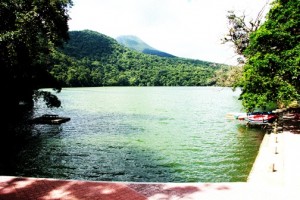
Outside the busy streets of Manila, in a province known more for pili nuts and whale sharks, is a gastronomic heaven. Sorsogon is many things to different people, but perhaps the best kept secret for those who have never been there is the food.
Bicol cuisine is a harmonious mix of textures, flavors and temperature in one meal. Coconut milk plays a big part in many dishes and chili is used quite liberally. It is therefore not surprising that the local fare is notorious for packing heat. Sorsogon does not disappoint. At the heart of the capital are a handful of restaurants ready to challenge one’s taste buds and serve old-time favorites like laing, pinangat and Bicol Express.
The real adventure, however, begins when you leave the capital. Every year, around 100,000 tourists visit Sorsogon, not quite at par with its neighbors. While the whale sharks of Donsol remain Bicol’s top attraction, many come and go without taking a side trip down south. It is clear that the absence of a strong support structure and the lack of information about the province have kept potential visitors out.
In many ways, Sorsogon remains a bucolic destination. As you travel from one town to the next, lush mountains greet you. There’s no decadent nightlife, opulent mansions or crowded beaches littered with overpriced restaurants. Instead, tourists prepared for the long drive are rewarded with white sand beaches and postcard-pretty lakes.
Roughly 19 kilometers or a 30-minute drive from Sorsogon is Gubat, a second-class municipality where the best surfing spots in the province can be found. The waves of Buenavista beckon, whispering the words local and foreign surfers have all heard. “Come,” the waves tell you. And you do. The clear, warm waters caress your feet as you try the board for the first time. In the villages of Pinontingan and Panganiban, the consistent reef breaks offer a challenge to the more experienced surfer.
From Gubat, travel to the town of Bulusan where you can find one of the most beautiful lakes in the country. Dubbed the “Switzerland of the Orient,” Bulusan Lake is surrounded by a rich rainforest and wildlife sanctuary reserve that features
Mt. Bulusan, Lake Aguingay and two mountain formations known as Hormahan and Sharp Peak. Heaven on earth is a more fitting description.
Travel a bit further to reach the small town of Matnog. In a country blessed with beautiful swimming spots, it is not an easy feat for a beach to stand out. Subic Beach Saday (small) and Subic Beach Dako (large) deliver in a very big way. Located in Sitio (sub-village) Calintaan, the beaches remain largely undisturbed, frequented mostly by locals. Your heart stops as you soak in the beauty of everything around you. It is one of the most spectacular beaches you will ever be in, where the sand is as white as it can be and the sea provides unspoiled coral reef formation. One struggles for words to share how truly breathtaking it is.
A tour of Sorsogon is not complete without tasting some of its best-kept secrets. Skip the regular fare and discover what each town has to offer. The province is blessed with an abundant marine life and this is evident in the local cuisine. Have a taste of the following:
1. Cupapa (Slipper Lobster). Lobsters may be a pricey indulgence even for seafood lovers, but the cupapa is worth every peso. The white meat is tasty even without the usual butter and lemon dip and the price is surprisingly cheaper compared to the more popular painted spiny lobster or rock lobster.
Caught mainly by hand, the cupapa grows to around 12 to 15 centimeters and can be found in the towns of Sta. Magdalena, Matnog, Barcelona and Bulusan. Steamed or grilled, the cupapa, also known as pitik-pitik, tops the list of what you should try whenever you are in Sorsogon.
2. Kinagang. To make this delicacy, mix one cup chopped river shrimp with five cups grated coconut, a half-cup of garlic, some herba buena (local mint) and salt. Nothing fancy. A key ingredient is the hagikhik leaf used to wrap the shrimp paste. The hagikhik plant gives the kinagang its distinct flavor. This dish can be eaten with rice or as a snack.
3. Tuwad-tuwad. This dish is definitely a must-try if you like snail meat. Harvested during low-tide, the tuwad-tuwad retains its briny ocean taste even after cooking. The rich coconut sauce enhances the flavor, giving it an extra oomph. Snail meat may be an acquired taste, but the tuwad-tuwad is the perfect choice for someone squeamish. No toothpick needed since the shell is smaller compared to the kuhol. You can also try another popular snail dish, the sikad-sikad.
4. Timitim. A different take on the traditional cassava cake. This light kakanin, which can be found only in Gubat, is steamed grated cassava mixed with pure coconut milk then topped with pili nuts. An ideal afternoon snack after hitting the beach.
5. Binut-ong. This is a delicacy that falls under the “Best Paired With” list. The binut-ong is glutinous rice wrapped in a pouch made of banana leaf and eaten traditionally as breakfast fare. Try it with sugar or santan (sweet coconut jam).
6. Alimango (mud crab) and Pawik (red frog crab or spanner crab). Not all crabs taste alike. Diet and water salinity greatly affect the taste of the meat. The proximity of several towns to the Pacific Ocean makes the mud crabs in Sorsogon tastier and sweeterThe pawik, a reddish brown crab more popularly known as curacha can be found in Matnog and Barcelona in Sorsogon, and in the waters of Zamboanga, Cagayan, Lagonoy Gulf and the San Bernardino Strait.
So which tastes better—the alimango or the pawik? Why not order both and see for yourself?
With its clean beaches, surfing waves, scenic countryside and unique local cuisine, Sorsogon is indeed a virtual feast for all senses.













































